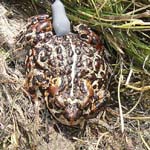
Have you seen this toad? Canadian toad populations are on the decline in Alberta.A University of Alberta researcher is strapping tiny backpacks to toads in an effort to discover why one species is in serious decline.
Connie Browne, a PhD student in the Department of Biological Sciences, is spending this summer haunting the ponds and sloughs in northern Alberta, Canada, using tiny radio transmitter backpacks to track Canadian and Western toads.
Browne hopes to capture 12 of each kind and using soft surgical tubing, she will belt the toads into tiny, waterproof oval 'backpacks' containing radio transmitters. The signals travel up to one kilometre and will allow Browne to locate the toads and to take note of their preferred habitat.
Browne began radio-tracking toads at Elk Island National Park east of Edmonton, Alberta last year, and confirming earlier research, was unable to spot a single Canadian toad. In fact, she's never seen one. The small, bumpy-skinned species, which dines on grasshoppers and other invertebrates, plays a valuable role in the food web and crop pest control. It has become locally extinct. "We've changed the environment so much, they can't survive anymore," Browne said. "It indicates the aspen parkland is not as healthy as it used to be."
Browne's studies will offer up clues as to how a balance can be struck between land development and the need to preserve breeding, foraging and hibernation habitats for toads and other amphibious species.
Some toads carry their transmitters for only a few days before slipping out of the belt, while others have worn them for as long as six months. Last year, Browne was able to track 12 toads to hibernation and describe their hibernation sites. The transmitters were then removed and the toads released for the winter.
Source : University of Alberta
 Print Article
Print Article Mail to a Friend
Mail to a Friend
